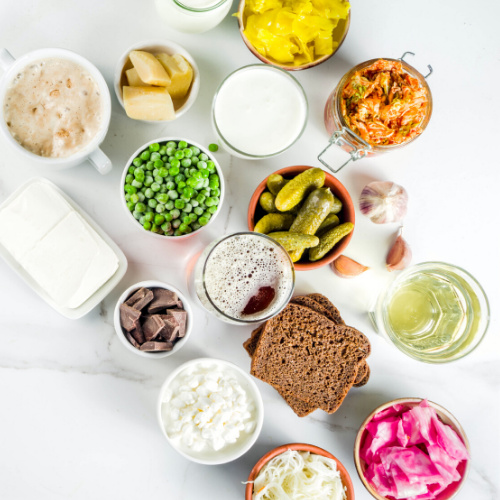Wellness In The Gut
What is your microbiome?
The gut microbiome consists of trillions of good bacteria, viruses, and yeasts that live together in our gut.
Every person has their very own unique collection of organisms.
Humans must have a gut microbiome to live.
Good nutrition, reducing stress, and increasing exercise all have positive effects on your microbiome.
How do we nourish our microbiome?
Eat foods high in prebiotic fiber
Add probiotic foods to diet
Minimize stress and have joyful daily activities
Sleep at least 7 hours a night
Exercise regularly
Take time to chew food and enjoy meals
What does the microbiome do?
Produces vitamins especially B vitamins
Digests carbohydrates and proteins
Generates energy for human cells Determines a person's metabolism
Communicates with our brain to keep us healthy
Controls blood sugar & risk of diabetes
Regulates cholesterol levels & plays a role in heart health
Prebiotics -Fiber that feeds the good bacteria
Definition:
A type of fiber in food that can survive harsh stomach acid and is not broken down in the small intestine
Must be able to be fuel for good bacteria living in our gut
This fiber is necessary to grow a diverse population of good bacteria
Benefits of prebiotic fiber
Good bacteria in your colon metabolize the fiber and produce energy for the human cells.
Countries with hight prebiotic fiber diets have less cancer and autoimmune disease
Recommend 10 to 15 grams prebiotic fiber daily
Prebiotic Foods
Agave
Apples with skin
Asparagus
Artichokes
Banana (green)
Berries
Black beans
Cherries
Chickpeas
Chicory Root
Dandelion greens
Eggplant
Flaxseeds
Garlic
Honey
Jerusalem artichokes (sunchokes)
Jicama
Kiwis
Leafy greens
Leeks/Onions
Lentils*
Mangoes
Oatmeal
Peas
Pears
Pumpkin
Quinoa
Radicchio
Spelt
Squash
Tomatoes
White beans
Wild yam
Gut Facts
95% of all serotonin is produced in the gut
Breast milk contains samples of mother's microbiome
1/3 of breast milk contains food for the baby's microbiome
The types of bacteria we feed control our cravings more than our brains.
Prebiotics- Resistance starch feeds good bacteria
What is a resistant starch?
A "resistant starch" means that this type of starch is not be broken down in our GI tract and reaches our good bacteria to be used for food.
Resistant starches are found grains, potatoes, and legumes (ex. beans, peas, lentils)
Resistant starches can help with weight loss, heart health and improve blood sugar.
1. Oats (gluten free)
3.5 ounces of oatmeal contains about 3.6 grams of resistant starch
High in antioxidants
Let oats cool for several hours or overnight to increase the resistant starch
2. Rice (all varieties)
Low-cost source of resistant starch
Red and black rice
Brown rice has more fiber and B vitamins
3. Legumes(beans, lentils, chickpeas)
Excellent sources of fiber and resistant starch
1 serving provides 1-4 grams of resist and starch
"Lectins" are plant proteins that may contribute leaky gut
Soaking and pressure cooking helps remove lectins
Cooking or heating destroys most resistant starches so it is best to eat these foods raw. Cooking & cooling the food after cooking can "recapture" the resistant starch content of some foods.
4. Green (Unripe Bananas)
High in resistant starch, which gets replaced with simple sugars as the banana ripens
Good source of vitamin B6 and vitamin C
5. Raw Potato Starch
Excellent source of resistant starch
Only need 1–2 tablespoons per day
Use as thickener added to smoothies, overnight oats or yogurts
Do not heat--instead, prepare the meal and then add the potato starch once the dish has cooled
6. Potatoes
Highest levels of resistant starch occur when cooked in bulk and allowed to cool for at least a few hours
Contains potassium and vitamin C
Do not reheat the potatoes-eat them cold as part of homemade potato salads or other similar meals
All starches should be organic and non-GMO when possible
Probiotics- Foods that feed the good
Probiotics are bacteria and yeasts found in fermented foods such as yogurt, kefir, sauerkraut and other fermented foods.
Probiotics are good bacteria and yeast that can help your own good probiotic bacteria live and grow when present.
Probiotics can help with leaky gut, irritable bowel syndrome, and antibiotic diarrhea
Probiotic Foods
Fermented grains
Fermented meats
Fermented veggies
Hard aged cheeses
Kefir (cow, goat)
Kimchi
Kombucha
Kvass
Lassi
Miso (organic, non GMO)
Natto
Pickled vegetables (raw)
Vinegars (raw)
Sourdough bread (with multi-day culture)
Sauerkraut
Sour cream
Yogurt (plain)
“We need to feed the garden that lives in our gut”
Yogurt vs. Kefir
Which has more health benifits?
Kefir is a powerful probiotic as it is loaded with probiotic bacteria and yeasts
Goat milk is closer to human milk than cow’s milk and less likely to inflame the gut
Patients with lactose intolerance can often tolerate kefir (goat) as most of the lactose is gone
Combine the Best of Both Worlds
Combine prebiotic and probiotics together
What is a synbiotic?
Definition:
Synbiotic: A combination of prebiotic and probiotic
Research suggests that consuming synbiotic foods may be more beneficial










